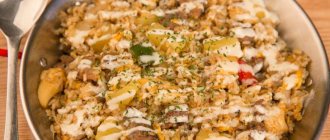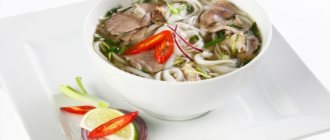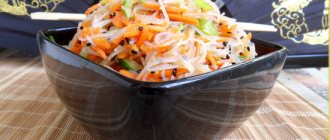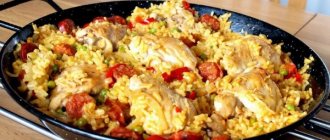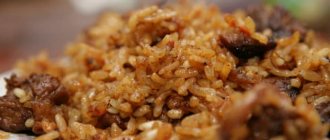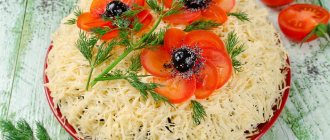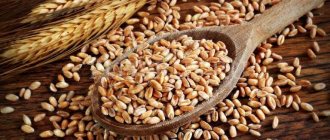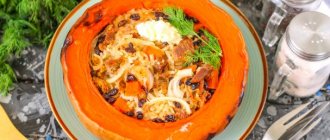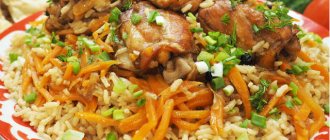Reviews (2)
18
Prepared by: Dashuta
10/01/2013 Cooking time: 1 hour 0 min
| Save | I cooked) | Estimate |
I offer for your consideration one of the most successful, in my opinion, options for low-calorie pilaf with chicken. The taste is simply excellent, and the damage to health and figure is minimal.
How is pp pilaf different from regular pilaf?
Firstly, the amount of oil. One of the secrets of any pilaf is not to skimp on vegetable oil. But with dietary interpretations, you can get by with one tablespoon. When cooking, be sure to use non-stick cookware - this makes it possible to reduce the amount of oil to a minimum.
Secondly, you need to choose the “right” meat. Traditional pork and lamb are not the best options. So, let's take the usual chicken fillet, turkey or veal (it takes a little longer to cook). You can also cook pilaf with shrimp and other seafood . Finally, instead of traditional white rice, you can use brown or brown rice, as well as bulgur.
When preparing any pilaf, do not forget about spices and garlic - everything here is the same as with classic recipes, there are no restrictions. Stock up on barberry, cumin, saffron and turmeric.
Here are some of the best diet pilaf recipes.
Diet pilaf with chicken in a frying pan. Specifics of the dish
The classic pilaf recipe involves using pork meat. This component makes the dish high in calories and fat. And besides, after it there may be heaviness in the stomach. But if you replace heavy pork meat with chicken, then the dish can be called dietary. There are several recipes for preparing dietary pilaf with chicken. In any case, before preparing it you need to buy in the store:
- rice (it must be steamed, otherwise you may end up with rice porridge instead of pilaf);
- chicken meat (preference should be given to chicken breast or fillet - this is one of the most dietary types of poultry meat);
- vegetables (carrots and onions are suitable. You can add any other vegetables if desired);
- spices (it is the spices that give rice a rich aroma and taste. These can be special
- seasonings “for pilaf” or any others that are usually added to rice).
- garlic (it is added at the final stage of cooking).
You can use any amount of rice and meat for cooking. On average, 500-600 grams of poultry meat is taken for 1.5-2 cups of rice. It is worth remembering that rice is cooked in a 1:3 ratio with water.
Important! Diet pilaf with chicken breast has less fat content than when using other meat.
Original recipe without rice or any other grains
Before moving on to the recipe itself, I want you to take a close look at the photo below. What do you see? A plate of delicious pilaf, isn’t it? In fact, there is no rice or other grains at all ! This is a unique dietary analogue of the famous dish, which is cooked with cauliflower! His kbju is so low-calorie and low-carbohydrate that this pilaf can be safely eaten for dinner even by those who are currently losing weight.
Nutritional value per 100 g:
- Calories: 60,6
- Proteins: 8
- Fats 1,4
- Carbohydrates: 4
Ingredients:
- cauliflower – 1 kg
- carrots - 150 g
- onion - 120 g
- chicken fillet – 500 g
- garlic - 2-3 cloves
- salt, pepper - to taste
- spices for pilaf - 1 tsp.
- olive oil 1 tbsp.
Cooking method:
Preparing everything is not difficult at all. First of all, in a thick-bottomed saucepan, sauté the garlic in olive oil.
Then add finely chopped onion and diced carrots. Simmer until golden brown. Don't fry, but rather stew - we have recipes for healthy, proper nutrition here!
Add chicken fillet, cut into small pieces. Simmer with vegetables for 5 minutes, stirring.
Grind the cabbage in a chopper or grate it. It’s convenient that you don’t have to divide it into inflorescences or cut off too much. Just cut the whole “bouquet” into convenient pieces and chop it!
Add cabbage to the pan, add spices, salt and pepper. Simmer for 10-15 minutes under the lid and turn off. Leave to brew for another 10-20 minutes.
Pilaf recipes for losing weight
With Chiken
Chicken meat contains a minimum of fat and the required amount of protein, so it is ideal for creating a dietary dish. Products:
- rice – 200 grams;
- chicken fillet – 200 grams;
- water – 400 ml;
- carrot – 1 piece;
- onion – 1 piece;
- vegetable oil – 1 tablespoon;
- dried apricots – 50 grams;
- garlic – 3 cloves;
- salt, spices - to taste.
Rinse the cereal thoroughly with water and drain off excess liquid. Wash the chicken breast and cut into medium pieces. Cut the peeled carrots into thin strips, the onions and dried apricots into smaller pieces. Wash the garlic well and wipe it dry; there is no need to peel it.
In a saucepan with a fairly dense and thick bottom, heat a little oil, place the pieces of meat, adding salt. Next, lightly fry the chicken for a couple of minutes. You should not wait for the golden crust, as it does not fit the dietary concept of the dish.
Then add the onion and mix thoroughly, after another 2-3 minutes add the chopped carrots and dried apricots. Simmer the vegetables and chicken for about 5 minutes. During this time, the carrots should lighten a little. Next, pour the rice into the pan and mix thoroughly.
Important! After rice, add salt and spices to the future dish so that the cereal has time to be saturated with aromas. You can add saffron, turmeric, red pepper, sweet paprika and a little coriander.
Pour about 400 ml of hot water into the pan, stir the entire contents and immerse the unpeeled garlic cloves inside. Cover the pilaf tightly with a lid and simmer over low heat for about 20-25 minutes. Then remove the dish from the stove and leave it to steep, the recommended time is 30-40 minutes.
With beef
This pilaf is a classic option and is suitable for red meat lovers. For a low-calorie option, use lean tenderloin. Products:
- beef – 400 g;
- rice – 1 kg;
- onion – 300 g;
- carrots – 300 g;
- vegetable oil – 10 g;
- salt, ground pepper - a pinch;
- garlic – 150 g.
Rinse the meat well and cut into large cubes. Heat the oil in a saucepan, then add the meat and fry it briefly for 5 minutes. Finely chop the onion and carrots and add to the meat, simmer over low heat for another 5 minutes. Then add salt and pepper, mix thoroughly and simmer for about 20 minutes.
Gently rinse and squeeze the rice, peel the garlic and put everything in a saucepan with the meat. Then add water so that it is covered with liquid by about 1 cm. Reduce heat and simmer, covered, until fully cooked. Approximate time – 30-40 minutes.
With mushrooms
Lenten dish with vegetables and appetizing mushroom aroma. For preparation you need:
- rice – 2 tbsp.;
- water – 800 ml;
- champignons – 400 g;
- carrots – 2 pcs.;
- onions – 2 pcs.;
- olive oil – 10 ml;
- greens - a bunch;
- garlic – 4 cloves;
- salt, spices - add to taste.
Wash the mushrooms and cut into slices. Peel the onions and chop evenly. Grate the washed carrots on a coarse grater. Next, heat a little oil in a special frying pan or saucepan, add onions and carrots. Then add the mushrooms and simmer this mixture for no more than 3-4 minutes.
Rinse the rice carefully and add to the vegetables; after 2 minutes, fill the container with boiling water and add salt to taste. Then place whole peeled garlic cloves into the pilaf base. Next, cook the pilaf covered for about 20 minutes. The finished dish should be served with chopped herbs.
Without meat
Vegetarian pilaf is low in calories and tastes great. Grocery list:
- rice – 400 g;
- water – 2 l;
- carrots – 1 pc.;
- onions – 1 pc.;
- garlic – 4 cloves;
- butter – 10 g;
- salt - to taste.
Peel and finely chop the onion; use a grater for carrots. Simmer the onions and carrots in a frying pan. Then add the washed rice, fill the dish with water and salt. Lastly, add the garlic cloves and simmer until tender (about 20 minutes).
With turkey
A dietary recipe with turkey meat perfectly diversifies your diet. For preparation you need:
- rice – 250 g;
- turkey fillet – 400 g;
- sweet pepper – 200 g;
- carrots – 200 g;
- oil – 1 tbsp. l.;
- salt - to taste;
- water – 500 ml.
Cut the turkey fillet into small pieces, then lightly fry the bird for a couple of minutes in olive oil. Add chopped bell peppers and grated carrots. Then add the washed rice, salt and water, mix everything thoroughly. Cook for approximately 30 minutes.
No oil
The most simple recipe for low-calorie pilaf, which is prepared without oil. Products:
- rice – 200 g;
- chicken fillet – 100 g;
- water – 400 ml;
- carrot – 1 pc.;
- onion – 1 pc.;
- salt, spices - to taste.
Wash the fillet and cut into small pieces. Peel the carrots and onions and chop thoroughly. Place the fillets in a suitable pan, fill it with water and bring to a boil.
Important! Periodically remove the foam during the boiling process, after which you can salt the water and add spices.
Boil the meat for 10 minutes and then add the carrots and onions, mix well. Cook for about 5 minutes. Add rice to the pan and bring to a boil, then simmer for 20 minutes until fully cooked.
PP pilaf with chicken and rice
This version of dietary pilaf is prepared with rice. However, I advise you to take brown instead of white, as it is much healthier. But you see for yourself, you can do an ordinary one.
KBJU per 100 g: 116/7.5/2.8/13.7
To prepare it you will need:
- non-deodorized vegetable oil - 1 tbsp.
- chicken fillet – 1 pc.
- brown rice - half as much as fillet
- carrots - the same amount as rice
- onion – 1 pc.
- salt, spices
- raisins - a handful.
How to cook:
- We wash the rice and leave it to dry. When rinsing, the water should become completely clear. So, we wash it 3-5 times. Dry on a paper towel.
- We cut the carrots into strips. To do this, first cut it into circles, then turn it into straws.
- Place a wok with oil on the stove. While everything is warming up, chop the onion. Pour oil to the very bottom of the wok. We put onions. If you have veal or lamb instead of fillet, first fry the meat, only after it add the onion. But the fillet can be placed immediately after the carrots.
- When the onion is slightly browned, add the carrots to it. Reduce the fire. Let's boil the water. If you have ready-made broth, you can use it, just bring it to a boil first. We cut the fillet.
- As soon as the carrots are browned, put the fillet in it. It is better to fry the spices together with fillet and vegetables.
- After the spices, it’s the turn of the rice; we also stew it with meat and vegetables for about 5 minutes. You can add raisins. Stir and add broth or water. The liquid should cover all components.
- Set the fire to maximum. Salt and add a whole clove of garlic (you can have it in the peel),
- When it boils, set the power of the stove to minimum. After three quarters of an hour you can turn it off.
Low-calorie pilaf in a slow cooker. How to cook dietary pilaf with chicken in a slow cooker
Pilaf is a famous Asian dish that is traditionally prepared from meat, rice, vegetables and spices with the addition of fat. The original recipes use pork or lamb, but the nutritional value of the dish can be significantly “lightened” by preparing dietary pilaf with chicken. And if you make it in a slow cooker, then it is quite possible to reduce the oil content to a minimum or even do without it altogether.
Diet pilaf
Of course, the combination of high-calorie fat with carbohydrate-rich rice can hardly be called a dietary food option. Animal fat in tandem with carbohydrates is converted into fat, which is then deposited under the skin of the person who abuses such treats. This is also indicated by the calorie content of an Asian dish prepared according to the original recipe. For a 100 gram serving it can reach as much as 500 kcal! As you know, for an adult who wants to lose weight, the average daily calorie intake is no more than 2000 kcal. Accordingly, if you consume only 300 g of such a treat, the limit will be almost exhausted. But this does not mean that such a tasty and beloved dish should be forgotten forever. Diet pilaf with chicken, prepared in a slow cooker, contains almost half as many calories, without compromising the taste and health benefits of the dish.
Meat for cooking pilaf
The main ingredient of pilaf is meat. And, as you know, it varies in nutritional value and fat content. The most high-calorie item is lamb. Pork is slightly inferior to it in this regard, and beef is even less nutritious. But the lowest calorie is chicken, in particular the breast. 100 g of chicken contains only 150-180 kcal.
Rice for pilaf
Another mandatory ingredient for preparing pilaf is rice, which is quite high in calories (100 g of cereal contains 360 kcal). But when cooked, rice absorbs water and becomes soft; as a result, in 100 g of the finished dish its nutritional value is no more than 150 kcal.
Classic round white rice is best suited for preparing pilaf.
But supporters of a healthy diet advise using brown rice, arguing that it contains many different microelements, and it is also more beneficial. The calorie content of such cereals does not differ from polished white ones. But the appearance and consistency of pilaf can be seriously affected by such changes in its composition. In this situation, each gourmet must determine for himself what is more important to him - the appetizing and taste of pilaf or its usefulness.
Vegetables
The third important component of pilaf is vegetables. In the dietary version of this dish they are very important. After all, they contain the minimum number of calories. In this regard, the more of them there are in pilaf, the more they “dilute” its calorie content. Traditionally, carrots and onions are added to the dish. According to the classic recipe, these vegetables are fried in a large amount of fat. But this is not a dietary option. It is possible, and even better, to do without frying at all or fry with a minimum of oil.
To reduce the calorie content of dietary pilaf, it is advisable to stew chopped vegetables directly in a slow cooker with chopped chicken. You can add a little water or a little olive oil if necessary.
Dietary pilaf: recipe
So, we offer a recipe for low-calorie chicken pilaf cooked in a slow cooker. To prepare it you will need:
- 300 g chicken breast;
- 150 g rice;
- 1 carrot;
- 1 onion;
- 1 tbsp. l. tomato paste;
- ½ tsp. ground pepper;
- salt to taste;
- 1 tsp. turmeric;
- greens and garlic to taste.
Spices
It is also worth focusing separately on the seasonings and spices for pilaf, which give this dish a subtle taste, piquancy and aroma. Pilaf is an oriental dish, and, as you know, Asian cooks simply adore spices and do not prepare almost a single dish without them. According to nutritionists, seasonings are very useful for people who want to lose weight. They significantly improve intestinal function, speed up metabolism, and this promotes weight loss. If desired, you can also add curry, hops-suneli, barberry and others to the dietary pilaf.
Cooking method
Let's look at how to prepare dietary pilaf. The process begins with processing the meat. The chicken breast is washed, dried with a towel and cut into small pieces. Lightly grease the multicooker bowl with vegetable oil, pour the meat into it and set it to the “Frying” mode. Next, the vegetables are prepared. Peeled carrots are grated on a fine grater, onions are cut into half rings or cubes. All vegetables are poured into the slow cooker with the meat and simmered until they become tender and soft. While the meat and vegetables are being cooked, soak the rice for 10-15 minutes in cold water, then rinse thoroughly and place in a strainer to drain. Pour water into the multicooker at the rate of 1 part dry rice to 2 parts water. Bring to a boil on the “Frying” mode and add rice, add tomato paste, seasonings and mix. Set the “Pilaf” mode. Cooking time may vary depending on the model of the electrical appliance and the volume of food. As a rule, this takes approximately 1-1.5 hours. There is no need to open the multicooker and stir the diet pilaf or perform other actions. The device itself will notify you with a sound signal about the end of cooking. The dish can be served immediately. Or leave the dietary pilaf in the multicooker on the “Warming” mode for a while. In this case, the dish will remain hot until meal time.
There are even lighter options for dietary pilaf - fruit, mushroom, with seafood, with eggplant. The calorie content of 100 g of such dishes can be only 100 kcal.
Bulgur pilaf in a slow cooker
Bulgur is an indispensable grain for fans of pp-cooking, many appreciate it (here is a selection of simple cooking recipes). It is also suitable for diet pilaf recipes. We will cook it in a slow cooker.
KBJU per 100 g: 141/6.3/2.4/23.5
We need:
- chicken breasts – 2 pcs.
- raisins – 150 g
- vegetable oil – 1 tbsp
- salt - to taste
- turmeric – 1 tsp.
- garlic – 3-4 cloves
- spices for pilaf
- onions – 2 pcs.
- carrots – 3 pcs.
- khmeli-suneli
- bulgur – 3.5 tbsp.
Cooking steps:
- Cut the onion into cubes and carrots into strips. We also cut the fillet into cubes. We wash the bulgur three times. Turn on the frying mode of the multicooker.
- First, onions and oil are sent there. After 3 minutes it’s the carrot’s turn. After 15 minutes, add the fillet, spices, raisins and salt. We wait 8 minutes and add bulgur and garlic.
- Pour boiled water (800ml) through a slotted spoon. We set the “pilaf” mode for 35 minutes. Let it brew and invite everyone to dinner!
Recipes
Fans of this dish will find a recipe for dietary chicken pilaf that suits them.
First
For it you will need the products listed above and 4 glasses of water. You can get water from the tap, but it is preferable to use filtered water. If a filter is installed on the water supply system, the problem is solved. In just a few steps you can prepare delicious and healthy chicken pilaf:
- Sort the rice, rinse well (the water should become clear) and set aside.
- Wash the poultry meat and cut into pieces. 400 grams of carrots and 1 onion, cut into small pieces.
- Heat the oil in a cauldron or deep frying pan and fry the chicken until golden brown (7-12 minutes).
- Add the onion, and after 5 minutes the carrots. Salt and pepper.
- After another five minutes, add water and bring to a boil. Simmer for 15-20 minutes.
- Add rice, placing it on top of the meat and frying. Turn on high heat, and when the water has almost boiled away, turn the heat to minimum and simmer until the water has completely evaporated.
- Wrap the cauldron in a towel and let the rice sit for half an hour.
Low-calorie pilaf in a frying pan
A similar pilaf can be easily prepared in a frying pan, preferably in a wok. The set of products is similar, it's just a matter of personal preference.
KBJU per 100 g: 93.7/9.6/1.2/9.5
To prepare we take:
- bulgur – 400 g
- turmeric
- any natural seasoning for pilaf – a tablespoon
- carrots – 400 g
- garlic – 5 cloves
- barberry
- onion -300 g
- olive oil – 1 tbsp.
- chicken – 1 kg.
Let's prepare it like this:
- Pour oil into the wok and wait until it warms up. Add onion and simmer until golden brown. Add carrots. Cut the chicken into pieces and add to the onion. Simmer over high heat, mix everything.
- Add spices and salt. Fill with water. Reduce heat and simmer for 10 minutes. Pour in the bulgur, fill it with water so that it covers the grain on your finger. Insert garlic. Simmer for a third of an hour under the lid.
- Mix. Add salt and pepper, let it warm up over low heat. This is such beauty.
Lenten vegetarian pilaf
Vegetarians are people too))) In general, it is quite possible to combine proper nutrition and vegetarianism, although it is not easy to do. PP pilaf with mushrooms and brown rice is an excellent example of this combination. The recipe is also suitable for those for whom the word “fasting” has a lot of meaning. We will cook it in a slow cooker.
KBJU per 100 g: 92/3.1/1.8/16.2
For preparation you need:
- brown rice - 0.5 kg
- royal champignons (or other mushrooms) – 0.5 kg
- bulb
- carrots – 2 pcs.
- vegetable oil – 1-1.5 tbsp.
- garlic – 5 pcs.
- salt, spices for pilaf
- black pepper
- turmeric
- boiling water – 900-1000 ml.
How to do:
- Soak the rice, and at this time set the multicooker to frying mode. Chop the onion and cut the carrots into strips. Place them in a multi bowl.
- We cut the mushrooms into 4 parts and send them there too. Mix everything. Add all the spices and salt and fry for 4-5 minutes.
- Strain and wash the rice. Place in a slow cooker. Pour boiling water over it. We set it to “pilaf” mode. Then add the garlic and set it to the same mode again. Cook, covered, for 30 minutes.
Red rice pilaf in the oven
Red rice is a rare thing, but worthy of the attention of a true food lover. And I suggest making pilaf with this grain without any vegetable oil at all. It's easy if you cook it in the oven! The main thing is to find a comfortable heat-resistant form. Thick-walled ceramic and cast iron are good for such purposes.
KBJU per 100 g: 103.7/10.4/2.2/9.1
To prepare we take:
- red rice – 150 g
- carrots - the same amount as rice
- chicken drumsticks with bones – 450 g
- bulb
- garlic, spices, salt.
- water - 300 ml.
Description of cooking:
- We wash the rice three times, remove the skin from the drumsticks, we don’t need excess animal fat with its calories. Cut the onion and carrots. We put the vegetables in a baking dish, red rice on them, and drumsticks on top.
- Mix water with spices and pour into the mold. Preheat the oven. Cover the form with foil.
- Place in the oven. Bake for about an hour at 180 degrees. It turns out crumbly, aromatic, very appetizing!
Main conclusions
Using a dietary recipe, you can prepare a hearty pilaf with minimal calories. It perfectly diversifies your diet and provides benefits for the body. Rules:
- emphasis on vegetables or dietary meats;
- reducing the amount of salt;
- adding a minimum amount of oil or eliminating it.
You can add your favorite vegetables, a variety of spices and dietary meat to low-calorie pilaf. Such recipes will make it easier to stay on a diet.
How often do you cook pilaf? How do you reduce its calorie content? Share with our readers in the comments below.
Pilaf with barley beef
Veal or beef are meats that are also suitable for pp recipes. But many people like it less than the popular chicken - it’s difficult to cook beef so that it’s tasty. But in pilaf it always “looks” good. Especially in combination with pearl barley.
KBJU per 100 g: 92.5/9.5/2.1/11.9
To prepare we take:
- veal – 150 g
- carrots – 100 g
- pearl barley - 75 g
- dried red bell pepper, dried garlic, salt, spices
- water – 170 ml
- vegetable oil – 1\2 tbsp
- onion – 50 g.
How to cook:
- We cut the veal into pieces approximately the size of a hazelnut. Turn on the multicooker to baking mode - the meat should be stewed. You can cook it in a regular frying pan.
- Wash the pearl barley, chop the onion and carrots. Add vegetables to meat. Fry, add oil.
- When the vegetables and meat are fried, add seasonings and add water. Mix. Add cereal and level. We turn off the “baking” function and switch to the “pilaf” function. Cook for 35 minutes.
Diet recipe with seafood
Any seafood is ideal for proper nutrition and weight loss! They contain a lot of protein, but almost no carbohydrates and fats. Do you remember that we already discussed this issue when we were preparing mussels? For our special pilaf recipes, seafood can and should also be used. This recipe contains mussels, but any others (squid, shrimp, etc.) can be safely used. It turns out very tasty. But the main secret here is to cook seafood so that its meat remains tender and juicy.
KBJU per 100 g: 97.2/4.6/1.7/13.3
For a large campaign you will need:
- brown rice - 500 g
- peeled boiled-frozen mussels – 400 g
- carrots - 2-3 pcs.
- onions - 2-3 pcs.
- dill, parsley
- vegetable oil - 1.5 tbsp.
- garlic, thyme, Provencal herbs, hot pepper, salt - to taste.
We prepare in several stages:
- We chopped onions and carrots, as in previous recipes, that is, onions - into cubes, carrots - into strips. Stew first the carrots in a deep cauldron, then the onions.
- Boil the rice in water separately. Here are all the nuances of cooking. We leave the mussels on the table to just defrost.
- Mix prepared rice, mussels, chopped garlic, herbs in a cauldron with stewed vegetables. Salt, pepper, add spices. Leave on low heat under a closed lid for 15 minutes. If necessary, stir a couple of times. Now the pilaf with mussels is ready.
Pilaf recipe without oil. Calorie, chemical composition and nutritional value.
Nutritional value and chemical composition of “pilaf without oil”.
The table shows the nutritional content (calories, proteins, fats, carbohydrates, vitamins and minerals) per 100 grams of edible portion.
| Nutrient | Quantity | Norm** | % of the norm in 100 g | % of the norm in 100 kcal | 100% normal |
| Calorie content | 161.3 kcal | 1684 kcal | 9.6% | 6% | 1044 g |
| Squirrels | 6.4 g | 76 g | 8.4% | 5.2% | 1188 g |
| Fats | 4.5 g | 56 g | 8% | 5% | 1244 g |
| Carbohydrates | 23.5 g | 219 g | 10.7% | 6.6% | 932 g |
| Alimentary fiber | 3.9 g | 20 g | 19.5% | 12.1% | 513 g |
| Water | 60 g | 2273 g | 2.6% | 1.6% | 3788 g |
| Ash | 1.7307 g | ~ | |||
| Vitamins | |||||
| Vitamin A, RE | 190.6 mcg | 900 mcg | 21.2% | 13.1% | 472 g |
| Retinol | 0.005 mg | ~ | |||
| beta carotene | 1.114 mg | 5 mg | 22.3% | 13.8% | 449 g |
| Lutein + Zeaxanthin | 23.1429 mcg | ~ | |||
| Vitamin B1, thiamine | 0.146 mg | 1.5 mg | 9.7% | 6% | 1027 g |
| Vitamin B2, riboflavin | 0.065 mg | 1.8 mg | 3.6% | 2.2% | 2769 g |
| Vitamin B4, choline | 40.15 mg | 500 mg | 8% | 5% | 1245 g |
| Vitamin B5, pantothenic | 0.463 mg | 5 mg | 9.3% | 5.8% | 1080 g |
| Vitamin B6, pyridoxine | 0.287 mg | 2 mg | 14.4% | 8.9% | 697 g |
| Vitamin B9, folates | 14.621 mcg | 400 mcg | 3.7% | 2.3% | 2736 g |
| Vitamin B12, cobalamin | 0.137 mcg | 3 mcg | 4.6% | 2.9% | 2190 g |
| Vitamin C, ascorbic acid | 1.18 mg | 90 mg | 1.3% | 0.8% | 7627 g |
| Vitamin D, calciferol | 0.021 mcg | 10 mcg | 0.2% | 0.1% | 47619 g |
| Vitamin D3, cholecalciferol | 0.0214 mcg | ~ | |||
| Vitamin E, alpha tocopherol, TE | 0.382 mg | 15 mg | 2.5% | 1.5% | 3927 g |
| gamma tocopherol | 0.0193 mg | ~ | |||
| Vitamin H, biotin | 4.406 mcg | 50 mcg | 8.8% | 5.5% | 1135 g |
| Vitamin K, phylloquinone | 1.7 mcg | 120 mcg | 1.4% | 0.9% | 7059 g |
| Vitamin RR, NE | 3.0259 mg | 20 mg | 15.1% | 9.4% | 661 g |
| Niacin | 1.464 mg | ~ | |||
| Betaine | 2.1 mg | ~ | |||
| Macronutrients | |||||
| Potassium, K | 187.14 mg | 2500 mg | 7.5% | 4.6% | 1336 g |
| Calcium, Ca | 23.13 mg | 1000 mg | 2.3% | 1.4% | 4323 g |
| Silicon, Si | 442.857 mg | 30 mg | 1476.2% | 915.2% | 7 g |
| Magnesium, Mg | 50.56 mg | 400 mg | 12.6% | 7.8% | 791 g |
| Sodium, Na | 29.93 mg | 1300 mg | 2.3% | 1.4% | 4343 g |
| Sera, S | 26.61 mg | 1000 mg | 2.7% | 1.7% | 3758 g |
| Phosphorus, P | 160.3 mg | 800 mg | 20% | 12.4% | 499 g |
| Chlorine, Cl | 50.04 mg | 2300 mg | 2.2% | 1.4% | 4596 g |
| Microelements | |||||
| Aluminium, Al | 384.3 mcg | ~ | |||
| Bor, B | 94.3 mcg | ~ | |||
| Vanadium, V | 142.86 mcg | ~ | |||
| Iron, Fe | 1.016 mg | 18 mg | 5.6% | 3.5% | 1772 g |
| Yod, I | 1.04 mcg | 150 mcg | 0.7% | 0.4% | 14423 g |
| Cobalt, Co | 2.821 mcg | 10 mcg | 28.2% | 17.5% | 354 g |
| Lithium, Li | 0.557 mcg | ~ | |||
| Manganese, Mn | 1.3171 mg | 2 mg | 65.9% | 40.9% | 152 g |
| Copper, Cu | 217.68 mcg | 1000 mcg | 21.8% | 13.5% | 459 g |
| Molybdenum, Mo | 9.536 mcg | 70 mcg | 13.6% | 8.4% | 734 g |
| Nickel, Ni | 18.643 mcg | ~ | |||
| Rubidium, Rb | 34 mcg | ~ | |||
| Selenium, Se | 11.159 mcg | 55 mcg | 20.3% | 12.6% | 493 g |
| Fluorine, F | 84.36 mcg | 4000 mcg | 2.1% | 1.3% | 4742 g |
| Chromium, Cr | 1.14 mcg | 50 mcg | 2.3% | 1.4% | 4386 g |
| Zinc, Zn | 0.9714 mg | 12 mg | 8.1% | 5% | 1235 g |
| Digestible carbohydrates | |||||
| Starch and dextrins | 21.954 g | ~ | |||
| Mono- and disaccharides (sugars) | 1.5 g | max 100 g | |||
| Galactose | 0.0286 g | ~ | |||
| Glucose (dextrose) | 0.325 g | ~ | |||
| Maltose | 0.0714 g | ~ | |||
| Sucrose | 0.9536 g | ~ | |||
| Fructose | 0.1786 g | ~ | |||
| Essential amino acids | 0.0494 g | ~ | |||
| Arginine* | 0.4734 g | ~ | |||
| Valin | 0.3096 g | ~ | |||
| Histidine* | 0.1681 g | ~ | |||
| Isoleucine | 0.26 g | ~ | |||
| Leucine | 0.5314 g | ~ | |||
| Lysine | 0.4159 g | ~ | |||
| Methionine | 0.1473 g | ~ | |||
| Methionine + Cysteine | 0.1069 g | ~ | |||
| Threonine | 0.2534 g | ~ | |||
| Tryptophan | 0.0695 g | ~ | |||
| Phenylalanine | 0.2851 g | ~ | |||
| Phenylalanine+Tyrosine | 0.2596 g | ~ | |||
| Nonessential amino acids | 0.1026 g | ~ | |||
| Alanin | 0.362 g | ~ | |||
| Aspartic acid | 0.5731 g | ~ | |||
| Glycine | 0.3432 g | ~ | |||
| Glutamic acid | 1.036 g | ~ | |||
| Proline | 0.2968 g | ~ | |||
| Serin | 0.2616 g | ~ | |||
| Tyrosine | 0.2293 g | ~ | |||
| Cysteine | 0.0906 g | ~ | |||
| Sterols (sterols) | |||||
| Cholesterol | 21 mg | max 300 mg | |||
| beta sitosterol | 17.8571 mg | ~ | |||
| Fatty acid | |||||
| Trans fats | 0.018 g | max 1.9 g | |||
| monounsaturated trans fats | 0.0126 g | ~ | |||
| polyunsaturated trans fats | 0.0054 g | ~ | |||
| Saturated fatty acids | |||||
| Saturated fatty acids | 1.1 g | max 18.7 g | |||
| 4:0 Oil | 0.0002 g | ~ | |||
| 8:0 Caprylic | 0.0004 g | ~ | |||
| 10:0 Kaprinovaya | 0.0004 g | ~ | |||
| 12:0 Lauric | 0.0017 g | ~ | |||
| 14:0 Miristinovaya | 0.0231 g | ~ | |||
| 15:0 Pentadecane | 0.0024 g | ~ | |||
| 16:0 Palmitinaya | 0.8701 g | ~ | |||
| 17:0 Margarine | 0.0041 g | ~ | |||
| 18:0 Stearic | 0.1945 g | ~ | |||
| 20:0 Arakhinovaya | 0.0059 g | ~ | |||
| 22:0 Begenovaya | 0.003 g | ~ | |||
| 24:0 Lignoceric | 0.0004 g | ~ | |||
| Monounsaturated fatty acids | 1.8229 g | min 16.8 g | 10.9% | 6.8% | |
| 14:1 Myristoleic | 0.0071 g | ~ | |||
| 16:1 Palmitoleic | 0.2123 g | ~ | |||
| 16:1 cis | 0.2072 g | ~ | |||
| 16:1 trans | 0.0015 g | ~ | |||
| 17:1 Heptadecene | 0.003 g | ~ | |||
| 18:1 Oleic (omega-9) | 1.5802 g | ~ | |||
| 18:1 cis | 1.2296 g | ~ | |||
| 18:1 trans | 0.0111 g | ~ | |||
| 20:1 Gadoleic (omega-9) | 0.0163 g | ~ | |||
| 22:1 Erucic (omega-9) | 0.0004 g | ~ | |||
| 22:1 cis | 0.0004 g | ~ | |||
| Polyunsaturated fatty acids | 1.0712 g | from 11.2 to 20.6 g | 9.6% | 6% | |
| 18:2 Linolevaya | 0.9774 g | ~ | |||
| 18:2 trans isomer, undetermined | 0.0054 g | ~ | |||
| 18:2 Omega-6, cis, cis | 0.6497 g | ~ | |||
| 18:2 Conjugated linoleic acid | 0.0047 g | ~ | |||
| 18:3 Linolenic | 0.049 g | ~ | |||
| 18:3 Omega-3, alpha-linolenic | 0.0306 g | ~ | |||
| 18:3 Omega-6, gamma-linolenic | 0.0041 g | ~ | |||
| 18:4 Steoride Omega-3 | 0.0006 g | ~ | |||
| 20:2 Eicosadiene, Omega-6, cis, cis | 0.0045 g | ~ | |||
| 20:3 Eicosatriene | 0.0073 g | ~ | |||
| 20:3 Omega-3 | 0.0002 g | ~ | |||
| 20:3 Omega-6 | 0.0071 g | ~ | |||
| 20:4 Arachidonic | 0.0225 g | ~ | |||
| 20:5 Eicosapentaenoic acid (EPA), Omega-3 | 0.0009 g | ~ | |||
| 22:4 Docosatetraenoic acid, Omega-6 | 0.0051 g | ~ | |||
| 22:5 Docosapentaenoic acid (DPA), Omega-3 | 0.0021 g | ~ | |||
| 22:6 Docosahexaenoic acid (DHA), Omega-3 | 0.0015 g | ~ | |||
| Omega-6 fatty acids | 1 g | from 4.7 to 16.8 g | 21.3% | 13.2% |
The energy value of pilaf without oil is 161.3 kcal.
Primary Source: Created in the application by the user. Read more.
** This table shows the average levels of vitamins and minerals for an adult. If you want to know the norms taking into account your gender, age and other factors, then use the “My Healthy Diet” application.
Secrets of delicious low-calorie pilaf
Feel free to add frozen vegetable mixtures to your pilaf. If desired, you can replace part of the cereal with them.
Experiments with spices and seasonings are welcome! They greatly influence the final taste of the dish.
As you can see, pilaf can be completely adjusted to the laws of proper nutrition. Experiment and you will succeed.
Irina Polyanitsa My name is Irina, I am the owner and admin of the site, as well as the author of most of the recipes and articles. I love to cook simple and healthy delicacies. Certified gym instructor, personal trainer. She completed a course on nutrition and health at Stanford University, Stanford Introduction to Food and Health, as well as a course at Ludwig Maximilian University of Munich (LMU) Nutrition and Lifestyle in Pregnancy (about nutrition and lifestyle during pregnancy).
Can pilaf be low-calorie?
Different regions have their own specific preparation of this dish. At the same time, the basic recipe for pilaf includes meat and cereal. All ingredients for the future pilaf are mixed in a single bowl and stewed until fully cooked.
Interesting! In addition to a large amount of vegetable oils and fatty pieces of meat, in some regions goat or lamb fat is added to pilaf.
Such recipes cannot be classified as a diet menu. The average calorie content of a standard serving is more than 800 kcal, which is equal to half the daily requirement of a person losing weight.
For this reason, recipes have been created for low-calorie pilaf without fat, which allows you to quickly satisfy your hunger or refresh yourself after a workout. It is approved for people with problems in the gastrointestinal tract, is easily digested and does not provoke weight gain. A variety of spices and recipes will make it easy to follow your chosen diet.
Be sure to check out:
